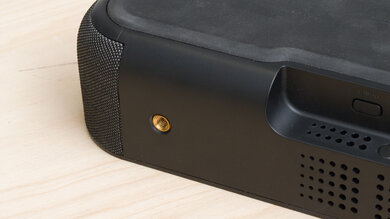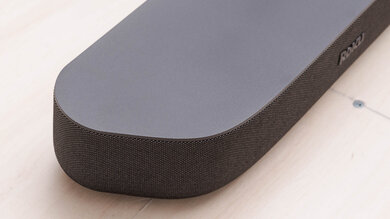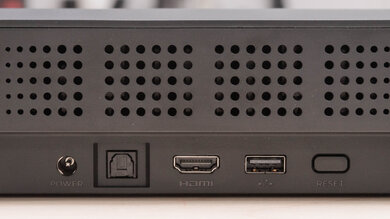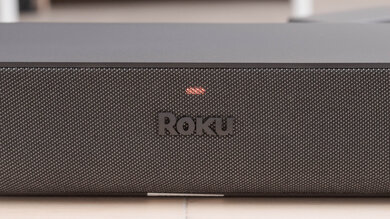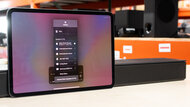The Roku Streambar is a budget-friendly 2.0 soundbar with a built-in media streamer, allowing you to access different streaming platforms like Netflix and Hulu via one interface. It's pretty similar to the Roku Streambar Pro and the Roku Smart Soundbar when it comes to sound quality, but as the manufacturer's smallest soundbar, it's best suited for those who are low on space. Also, there are separate subwoofers and satellites available for those who want to upgrade their setup.
Our Verdict
The Roku Streambar is acceptable for mixed usage. This 2.0 soundbar is ideal for listening to stereo content, which includes most music and dialogue-focused TV shows. Voices in podcasts and sitcoms are clearly reproduced, and instruments in your favorite tunes are detailed in the mix. That said, like with most small standalone bars, you don't feel the rumble in the low-bass during bass-heavy tracks. Its surround sound isn't the most impressive, either. However, you can always upgrade it down the line with a sub and satellites if you want.
- Four EQ presets available.
The Roku Streambar is adequate for dialogue-centric TV shows and podcasts. It's a 2.0 bar, meaning you don't get a discrete center channel to improve vocal reproduction. Despite that, its mids are pretty balanced, so it can still reproduce vocals with some clarity, making it easy to follow the action on screen. There's an adjustable Speech Clarity feature available to make dialogue more crisp, as well as an adjustable Volume Mode to quiet loud commercials.
- Dialogue enhancement feature available.
The Roku Streambar is passable for music. Out-of-the-box, it has a fairly balanced sound, with neutral mids that reproduce voices and lead instruments with detail. As a result, it's suitable for most music genres. Like most small standalone bars, it lacks the thump and rumble in the bass with bass-heavy genres like EDM and hip-hop. A firmware update gives you bass and treble adjustments to customize its sound, but if you want solid bass reproduction, you'll need to add on a separate sub from the manufacturer.
- Four EQ presets available.
- Bass and treble adjustments.
- Really lacking low-bass.
The Roku Streambar is disappointing for movies. Since it's a 2.0 bar, it has to downmix 5.1 surround sound formats like Dolby Digital into stereo to play them. The resulting sound isn't very immersive, and sound effects don't seem to wrap into the space around your couch. You can always add on separate satellites to improve its performance. Unfortunately, you can't watch Dolby Atmos content, which is really disappointing since this format is so common on the streaming platforms found on Roku's media streamer.
- Four EQ presets available.
- Really lacking low-bass.
Changelog
- Updated Nov 13, 2024:
This review's Audio Format Support - ARC box was updated to mention the TCL S45H.
- Updated Oct 11, 2024: This review has been updated to mention the Roku Streambar SE in the Frequency Response Accuracy section.
- Updated Jan 12, 2024: Added market comparison for the TCL Alto 6 in the Stereo Frequency Response box.
- Updated Oct 23, 2023: Minor updates to review text for clarity.
Check Price
Differences Between Sizes And Variants
This soundbar comes in one color: 'Black'. You can see the label for the model we tested here.
If you come across a version that's different from our test unit, let us know in the forums, and we'll update our review.
Popular Soundbar Comparisons
The Roku Streambar is a budget-level 2.0 setup from 2020. This small soundbar offers access to several streaming platforms in one place through Roku's media streamer. It's a smaller alternative to the Roku Streambar Pro that's ideal for smaller spaces. Of course, there's a trade-off in terms of low-frequency extension, so you notice less rumble in the bass than with the Pro.
For more options, check out our recommendations for the best small soundbars, the best soundbars under $200, and the best soundbars for dialogue.
The Roku Streambar SE is a cheaper, pared-down version of the Roku Streambar. Both come with a selection of wireless connectivity options, including Wi-Fi and Airplay compatibility, as well as integrated access to streaming apps. However, there are some caveats that come with the SE version's price. It compresses much more at max volume and can't get as loud. It also isn't as well-built and doesn't support Dolby Digital.
The Roku Streambar is a smaller alternative to the Roku Streambar Pro. It offers a more compact design, which is great if you're low on space. Because of its small size, it doesn't reproduce as much bass as the Pro, which is especially noticeable with bass-heavy music like EDM. The Pro's remote adds a private listening tool thanks to the headphone jack on the remote, and it has two programmable controls so you can access common voice controls with the press of a button. Otherwise, there isn't much of a difference in their performance.
The Roku Smart Soundbar is a better 2.0 soundbar than the Roku Streambar. These two soundbars have the same physical inputs and sound enhancement features. However, the Smart Soundbar has a significantly better-balanced sound profile and its surround performance is much better, too. It can also get louder, although there are more compression artifacts than the Streambar. However, the Streambar has a better center channel performance.
The Sonos Beam is a significantly better soundbar than the Roku Streambar. The Sonos is a 3.0 setup that's better balanced and has a better center and surround performance. It also has more sound enhancement features and can get much louder, with some compression artifacts present. However, the Roku is a 2.0 setup with more physical inputs. You can also wirelessly stream your favorite audio to the bar using Bluetooth.
Test Results

This bar is a smaller and more compact alternative to other models like the Roku Smart Soundbar and the Roku Streambar Pro. It has a nondescript design, with fabric wrapping around the front and the sides.
You can purchase a Roku Wireless Subwoofer separately.
The bar has a good build quality. It's mostly made of hard plastic, which feels very sturdy and durable. The rubber underneath the bar helps to hold it in place. Fabric wraps around the front and sides of the bar, and its tight fit means it isn't likely to rip. Still, it can collect some dust over time.
This 2.0 setup is ideal for listening to stereo content, which includes most music and vocal-heavy TV shows. Its frequency response is quite balanced, especially in the mids, where most voices and instruments reproduce, so you get a clear and accurate representation of these sounds. However, there's a slight dip in the treble range, so higher-pitched instruments like hi-hats are a bit veiled in the mix. Given its small size, it struggles to bring any thump or rumble in the low bass, even compared to other standalone budget models like the TCL Alto 6 or the paired-down Roku Streambar SE. However, you can always add a separate sub to improve its performance.
If you update the bar to firmware version 11.0.0 or later, you get access to bass and treble adjustments to help you customize its sound to your liking. With its bass set to '8', you get a more balanced sound, with a bit more thump in the bass range to bring bass-heavy genres like EDM and hip-hop to life. The mids remain quite balanced, so voices and lead instruments are still clear and detailed in the mix.
The Roku Streambar's stereo soundstage is fair. The soundstage extends past its edges, which is impressive for such a small bar, but it doesn't do any tricks to make it sound larger than that. Focus is okay, but sounds seem to accelerate toward the far sides of the bar. That said, the focus is much more consistent towards the center, so objects like instruments are perceived as coming from accurate, pinpoint locations.
This soundbar doesn't get as loud as many others we've tested and won't be loud enough for a large or crowded room, but that's normal with its small size. Fortunately, it's still suitable for listening in an average-sized living room. Also, there isn't a lot of compression when you push it to max volume, so sound quality doesn't degrade as you crank up the volume.
The Roku Streambar has a decent THD performance. There isn't a lot of distortion at normal listening levels, resulting in clean and pure audio reproduction. As with most bars, if you push the bar to its max volume, there's a jump in THD. However, this isn't very noticeable with real-life content unless you're a very astute audiophile.
This 2.0 setup lacks a discrete center channel to improve vocal reproduction. Instead, it uses its left and right stereo channels to simulate a phantom center, which isn't quite as accurate. That said, the frequency response on this phantom channel is very even, especially in the mids, where most voices are reproduced. As a result, dialogue is still clear and easy to follow in the mix.
This bar has poor surrounds performance. It has to downmix this content into stereo to play it, which doesn't sound as immersive as a setup with dedicated satellite speakers. When you watch movies like Ford v Ferrari (2019), you don't get the sense of cars driving past you during race scenes. Instead, sound effects are concentrated in the space in front of you. You can always add on separate satellites if you want to improve this bar's surround sound, though.
This soundbar has a few sound enhancement features. It offers four EQ presets: 'Standard', 'Dialogue', 'Movie', 'Music', and 'Night'. There's also a Volume Mode feature to quiet loud commercials. You can set it to 'Off', 'Leveling', or 'Night Mode' depending on how much you want to balance the sound between your programs. There's also an adjustable Speech Clarity feature to make voices crisper, and you can choose between 'Off', 'Low', and 'High'. If you update it to firmware version 11.0.0 or higher, you get bass and treble adjustments to customize its sound.
You can connect the bar to your TV via Optical. Also, if your TV has HDMI ARC, you can connect it over an HDMI cable. Most TVs have this technology built-in; however, older TVs may not. In that case, you can connect it over Optical and HDMI to get it to play.
The Roku Streambar supports Dolby Digital content, which is commonly found on Blu-ray discs as well as streaming platforms. However, since it's a 2.0 bar, it has to downmix it into stereo to play it. It doesn't support lossless or object-based formats like Atmos, though. For more extensive audio format support, consider the TCL S45H, which offers Dolby Atmos (though it's still downmixed) and DTS.
The Roku Streambar can only support Dolby Digital content via Optical, which is commonly found on Blu-ray discs or streaming platforms. That said, it lacks DTS support.
Latency is fairly low. You don't notice any delay between the audio you hear and the video you see on screen. Some apps and TVs compensate for latency differently, though.
It's easy to wirelessly stream audio from your mobile devices to the bar. It doesn't support Chromecast built-in, though, which is a bit disappointing if you have a lot of Google devices.
This soundbar doesn't have an HDMI In port, so it doesn't support high-quality passthrough.
The bar doesn't have a display. Just like the Roku Smart Soundbar, it has a light in the center of the bar. It turns solid red when you've plugged it in and turns green when it's ready. The light also slowly pulses when you're on mute, and it turns white for a moment to indicate that you've made a command. Unfortunately, there's no way of knowing its volume level if the TV is off.
You can control almost all of the bar's features with its remote. Unlike the Roku Streambar Pro, you can't connect headphones to the remote itself for private listening—you have to do that through the Roku Streambar app instead. The app also acts as a remote, so if you'd rather control the bar from your smartphone, you can do that there.
The bar has its own voice assistant built into the remote. You can press the microphone button on the remote or use the app to activate it. Also, you can use a third-party Google Home, Amazon Alexa, and/or compatible Apple Homekit for voice assistant support. You just need to set them up in the Google Home, Amazon Alexa, or Apple Home apps, respectively, to stream them on the bar.



